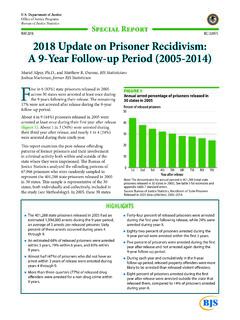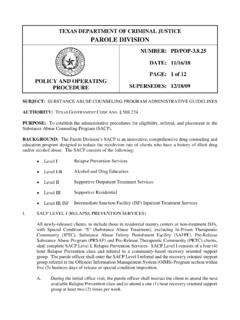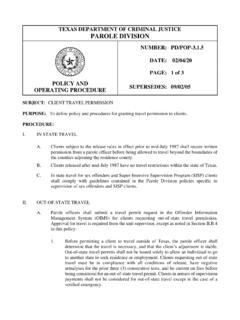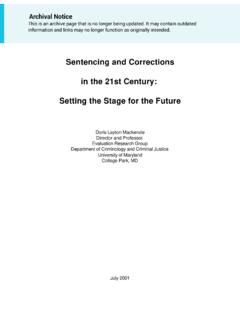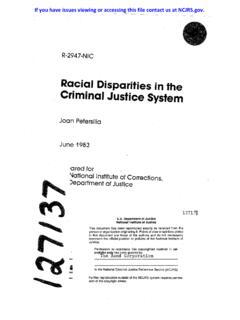Transcription of Prisoners in 2020 – Statistical Tables
1 Department of justice Office of justice Programs Bureau of justice StatisticsBureau of justice Statistics Statistical Tables December 2021, NCJ 302776 Prisoners in 2020 Statistical Tables Carson, , BJS StatisticianIn 2020, the number of persons held in state or federal prisons in the United States declined 15%, from 1,430,200 at yearend 2019 to 1,215,800 at yearend 2020. Only Alaska showed an increase (2%) in its prison population, while other jurisdictions showed declines of 7% to 31%. Te number of persons sentenced to more than 1 year in state or federal prison decreased from 1,379,800 in 2019 to 1,182,200 in 2020.
2 Te combined state and federal imprisonment rate for 2020 (358 per 100,000 residents) represented a decrease of 15% from 2019 (419 per 100,000 residents) and a decrease of 28% from 2010 (500 per 100,000 residents) (fgure 1). Te COVID-19 pandemic was largely responsible for the decline in Prisoners under state and federal correctional authority. Courts signifcantly altered operations for part or all of 2020, leading to delays in trials and/or sentencing of persons, and this was refected in the 40% decrease in admissions to state and federal prison from 2019. While the number of releases also declined during 2020, releases occurred at a slower rate FIGURE 1 Imprisonment rate per 100,000 residents, by age, 2010 2020 Rate per 100,000 700 Age 18 or older 600 500 All ages 400 300 200 100 0 2010 2011 2012 2013 2014 2015 2016 2017 2018 2019 2020 Note: Imprisonment rate is the number of sentenced Prisoners under state or federal jurisdiction per 100,000 residents.
3 Rates are presented for all ages and age 18 or older as of December 31 of each year and are based on Prisoners with a sentence of more than 1 year. See appendix table 1 for rates. Source: Bureau of justice Statistics, National Prisoner Statistics, 2010 2020; and Census Bureau, postcensal resident population estimates for January 1 of the following calendar year. Highlights At yearend 2020, the number of Prisoners understate or federal jurisdiction had decreased by214,300 (down 15%) from 2019 and by 399,700(down 25%) from 2009, the year the number ofprisoners in the United States peaked.
4 Nine states showed decreases in the numberof persons in prison of at least 20% from 2019to 2020. The prison populations of California, Texas, andthe Federal Bureau of Prisons each declined bymore than 22,500 from 2019 to 2020, accountingfor 33% of the total prison population decrease. In 2020, the imprisonment rate was 358 per100,000 residents, the lowest since 1992. From 2010 to 2020, the sentenced imprisonmentrate for residents fell 37% among blacks;32% among Hispanics; 32% among Asians,Native Hawaiians, and Other Pacifc Islanders;26% among whites; and 25% among AmericanIndians and Alaska Natives.
5 The number of admissions to federal prison(down 19,000) and to state prison (down 211,800)both declined by 40% from 2019 to 2020. Releases from federal and state prisonsdecreased during 2020 (down 58,400 or almost10% from 2019), but at a lower rate than thedecrease in in 2020 Statistical Tables | December 2021 2 BlackaAmerican Indian/Alaska NativeaWhitea(10%) than the decrease in admissions. Although deaths represented 1% of the total releases from prison in 2020, the number Prisoners that died under the jurisdiction of state or federal correctional authorities in 2020 (6,100 Prisoners ) increased 46% from 2019 (4,200).
6 From 2019 to 2020, the decline in the number of females sentenced to more than 1 year in prison (down 22%) outpaced the decrease in sentenced male Prisoners (down 14%). Te imprisonment rates for residents in all racial or ethnic categories decreased by 12% to 16% from 2019 to 2020 and by at least 25% from 2010 to 2020 (fgure 2). Te imprisonment rate for black residents decreased 37%, from 1,489 per 100,000 in 2010 to 938 per 100,000 in 2020. Findings in this report are based on the National Prisoner Statistics (NPS) program, administered by the Bureau of justice Statistics (BJS). Te program collects annual data from state departments of corrections (DOCs) and the Federal Bureau of Prisons (BOP) on prison capacity and prisoner counts, characteristics, admissions, and releases.
7 Tis report is the ninety-ffh in a series that began in 1926. Forty-eight states and the BOP reported NPS data for 2020. Oregon submitted 2020 data to the National Corrections Reporting Program, which BJS used to impute 2020 NPS responses. BJS obtained data for New Hampshire from other source and imputed NPS responses, which the state DOC approved. (See Methodology.) FIGURE 2 Imprisonment rates of residents, based on sentenced Prisoners under the jurisdiction of state or federal correctional authorities, per 100,000 residents, by race or ethnicity, 2010 2020 Rate per 100,000 1,600 Blacka 1,400 1,200 American Indian/Alaska Nativea 1,000 800 Hispanic 600 400 Whitea Asiana,b 200 0 2010 2011 2012 2013 2014 2015 2016 2017 2018 2019 2020 Note: Jurisdiction refers to the legal authority of state or federal correctional ofcials over a prisoner, regardless of where the prisoner is held.
8 Imprisonment rate is the number of sentenced Prisoners under state or federal jurisdiction per 100,000 residents in a given category. Rates are for December 31 of each year and are based on Prisoners with a sentence of more than 1 year. Resident population estimates are from the Census Bureau for January 1 of the following year. As of December 31, 2001, sentenced felons from the District of Columbia were the responsibility of the Federal Bureau of Prisons. See table 5 for rates. aExcludes persons of Hispanic origin ( , white refers to non-Hispanic whites and black refers to non-Hispanic blacks).
9 See Methodology. bIncludes Native Hawaiians and Other Pacifc Islanders. Source: Bureau of justice Statistics, Federal justice Statistics Program, 2020 (preliminary), National Corrections Reporting Program, 2019, National Prisoner Statistics, 2010 2020, Survey of Inmates in State and Federal Correctional Facilities, 2004, and Survey of Prison Inmates, 2016; and Census Bureau, postcensal resident population estimates for January 1 of the following calendar year. Prisoners in 2020 Statistical Tables | December 2021 3 Efects of the coronavirus (COVID-19) pandemic on prisons The COVID-19 pandemic had signifcant efects on all stages of the criminal justice process, including state and federal correctional systems.
10 In most states, courts signifcantly altered operations for part or all of 2020, leading to delays in trials and/or sentencing of persons and decreasing the overall number of admissions to prison. At the same time, states and the Federal Bureau of Prisons adopted an array of policies to mitigate transmission of COVID-19, including the suspension of transfers between prison facilities or from local jails to prisons; expedited releases of persons in prison based on their crimes, time served, and behavior; and releases to home confnement. All of these factors contributed to the 15% decline in the total prison population from yearend 2019 to yearend 2020 described in this report.
